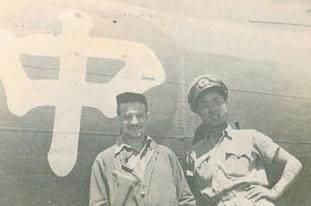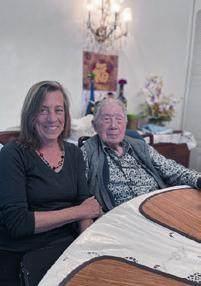Lasting Memories And Friendship
2022-05-30ByLiNan
By Li Nan


In March this year, 70-year-old Eve Coulson made the 4,700-km journey from New Jersey to California to visit her 109-yearold Chinese-born “uncle” Moon Fun Chin. As far as she knows, Chin is one of the few surviving pilots in the U.S. who flew “the Hump,” a transHimalayan air route for delivering supplies to China to fight against the Japanese invaders during World War II (WWII).
Another survivor is Peter J. Goutiere, who turned 108 on September 28 this year. He, along with Chin and Coulsons father, Ursel Elbert Coulson, were pilots for the China National Aviation Corporation (CNAC). Coulson Sr., who flew 99 Hump trips, worked closely with Goutiere in China in the early 1940s. CNAC was a Sino-U.S joint venture established in 1929. Most of its pilots were foreigners and the majority of its co-pilots and radio operators were Chinese.
Flying the Hump
Japanese troops invaded the northeastern region of China on September 18, 1931, and launched a full-scale invasion of China in July 1937. By 1940, the Japanese had taken control of almost all harbors along Chinas coastline, leaving the Burma Road which linked the Yunnan Provincial capital, Kunming, with Lashio in neighboring Burma (now Myanmar), as the only practical route for international supplies into China. At that time, Burma was a British colony.
On December 7, 1941, Japan attacked Pearl Harbor, triggering the outbreak of the Pacific War. China entered the Anti-Fascist Alliance on January 1, 1942 and teamed up with the U.S. and the UK to fight against their common enemies in the China Burma India Theater.
Initially, military and other supplies from the U.S. were first transported to India and then delivered to China via the Burma Road. However, after Burmas submission to the Japanese in May 1942, the road was closed, leaving Chinas war of resistance entirely cut off from international supplies.
To support China in the war against Japan, the India-China Division of the Air Transport Command (ATC) of the U.S. Army and the CNAC worked together to airlift the supplies from Assam in India to Yunnan and Sichuan provinces in southwest China.
When the pilots crossed the southern section of Himalayas, the Gaoligong Mountains and Hengduan Mountains, with a height between 4,500 and 5,500 meters, the peaks looked to them like the humps of a camel. It is from this resemblance that the air route came to be known as the Hump. It was the military supply lifeline for China from 1942 to 1945.
High altitude, perilous weather, Japanese fighter planes and overwork were among the major dangers faced by the pilots on each supply mission. Between June and December 1943, the India-China Division of the ATC lost 155 aircraft and 168 crew members, not including passengers. “Flying the Hump was considered as hazardous as flying a combat mission over Germany,” William Henry Tunner, Commander of the India-China Division of the ATC, wrote in his memoir Over the Hump, published in 1964.

The Hump was not a single route but a collection of routes between 13 bases in India and six in China. Of the two main east-west routes, the 820-km southern route was shorter and the mountains were lower. However, its position close to Japanese-controlled Burma put it within striking distance of Japanese fighter planes and the supply missions were often attacked. With a length of 1,150 km, the northern route was longer, higher and often no less perilous, as the higher altitude crossing meant pilots and crew faced frequent extreme weather events.
The routes covered a vast area, subjecting pilots to conditions ranging from torrential rain in the tropical south to dust storms in desert regions and blizzards in the high mountains to the north.
Adding to the risk, there were no weather stations along the Hump. The best source of weather information came from the pilots who had just flown through each area. However, “the weather on the Hump changed from minute to minute, mile to mile,” Tunner wrote.
January 6, 1945 was the most tragic day in the history of the Hump. Winds at speeds of 161 km per hour created strong updrafts over the ridges and downdrafts over the valleys. The radios were filled with cries of “mayday”and a total of 15 aircraft, including nine planes of the India-China Division of the ATC, were lost on that single day, all due to bad weather.
The Japanese also posed a constant threat. After the Japanese took over Burma in May 1942, their fighter planes often flew south to north to intercept the cargo planes that flew west to east to carry supplies to China. To avoid the Japanese attacks, Hump pilots had to fly longer and farther over higher mountains.
On October 13, 1943, the CNACs No.72 cargo plane was shot down by three Japanese fighter planes. All three crew members were killed. From then on, the CNAC decided to either exclusively fly the northern route or fly at night.
For Deng Chonghuang, a former CNAC co-pilot, the most difficult and dangerous year over the Hump was 1944. “The Japanese were attacking us crazily that year,” Deng wrote on November 15, 2003 in a letter to Liu Xiaotong, a Chinese reporter who spent six years interviewing former CNAC employees. Deng joined the CNAC in 1943 and completed about 600 Hump flights before the end of WWII.
“You asked me how it felt flying over the Hump? It was the fatigue. Other than the terrible weather and Japanese fighter planes, we had to fly round the clock. I can still feel the exhaustion today,” Deng wrote on October 29, 2003 in another letter to Liu. The high accident rate resulted in severe shortage of professional staff. CNAC employees often flew two round trips in one day.“We all knew that it was the only lifeline to our country. As long as the war hadnt ended, the cargo flights couldnt cease. There needed to be someone to deliver the supplies,” Deng wrote.
In December 1944, Deng and a captain were conducting a night flight over the Hump. The captain asked Deng to take a nap. When Deng had almost fallen asleep, he was suddenly alerted as he felt the airplane rapidly descending. He found that the captain had fallen asleep with his arms on the controls, sending the airplane into a spiral. He immediately woke the captain and together they quickly regained control of the plane. Had they not done so within 20 seconds, they would have crashed. From that night on, Deng never came close to falling asleep on a mission again. “And I have been suffering from frequent insomnia to this day,” Deng added in another letter to Liu on November 15, 2003. Deng passed away on August 14, 2014.
The only lifeline
When Tunner first flew over the Hump as a pilot on August 25, 1944, he spotted a trail of gleaming aluminum through the mountains, a trail he soon discovered to be the remains of crashed American planes.
When planes crashed over the Hump, the chance of survival was slim. Most pilots who bailed out died of hunger, cold, wounds or even Japanese attacks. But there were some exceptions, including Coulsons father, who lost an engine while flying over the Hump on August 31, 1944. He and his crew had to bail out over the jungle of north Burma. He landed in a tree where the ground was heavily covered with underbrush. To survive, he even sustained himself on leeches. Eventually, he found a village whose leader connected him to the search party. He was the lone survivor of the incident.

Every American airman who helped with Chinas resistance against Japan received a “passport to safety”from the then Chinese government—a strip of silk with Chinese characters which read, “This is a foreigner who helps China to fight. Be you military or civilian, please help and protect him or her.” Many pilots stitched the silk inside their jackets or on their backs. And it worked. Most Chinese voluntarily came to their aid when they were forced down. As Tunner put it,“Once in China, the airmen would find nearly all natives friendly and most helpful.”
Thanks to the concerted efforts of the ATC and the CNAC, more than 800,000 tons of military supplies and other critical materials were airlifted to China from 1942 to 1945, providing much needed support not only for the Chinese army but also the Flying Tigers, or the American Volunteer Group founded and commanded by Claire Chennault in 1941 as an air force to directly resist the Japanese in China. Later, the Flying Tigers were incorporated into the U.S. 14th Air Force on July 4, 1942. “If it hadnt been for you and your convictions and your fine ATC organization, we wouldnt have won the war in China,” Chennault told Tunner many years later at a ceremony honoring the Chennault couple in Washington.
In addition to materials, the CNAC also carried military personnel, such as aviation pioneer James Doolittle, to escape from the Japanese. After the Pearl Harbor attack, Doolittle and his bombers broke through Japanese defenses on April 18, 1942 to strike Tokyo and other cities in Japan. It was Chin who flew Doolittle to India after theyd accomplished the secret mission.
Chin was among the first pilots to chart a path across the Hump. He was born in Guangdong Province in 1913 and emigrated to the U.S. when he was very young. He joined the CNAC on March 1, 1933, first working as a mechanic, then a co-pilot and finally a pilot in 1936. During the war, he flew at least 300 flights over the hump.
Continuous connections
This year marks the 80th anniversary of the Hump Mission. Over the past eight decades, some plane and pilot remains have been found in Yunnan and Tibet Autonomous Region. However, many have yet to be found. In midMay this year, a team of volunteers and rescuers hiked into the Cangshan Mountains in Dali, Yunnan, in search of a lost CNAC transport plane. Though the attempt failed, it drew public attention to the Hump.
There are still many people who work hard to keep the Hump memories alive and who cherish the legacy that comes along with them. Coulson is one of them. “I am proud of being a descendant of a Hump pilot. My pride has grown over time,” she told Beijing Review.
Coulson is now vice president of the CNAC Association, a post-WWII reunion group in the U.S. that began meeting in 1954. She believes that person-to-person connections are helpful for improving Sino-U.S. ties, which have reached a low ebb in recent years. “I also think we have to have good leaders at the top, who set good examples and dont make things worse!”
Zhu Junkun, head of the Yunnan Flying Tigers Research Institute, has kept in touch with many descendants of the Hump pilots and Flying Tigers. “We all believe that difficulties are temporary and friendship is the way forward,” Zhu told Beijing Review. “The Hump is a good example of how the two countries worked together to tackle common challenges,”he added. BR
